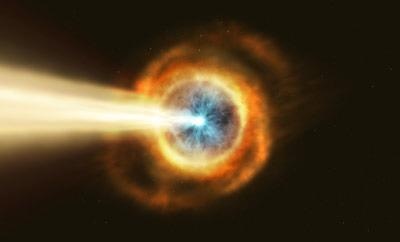Reviewed by Alex SmithApr 5 2022
A new mathematical model developed by RIKEN scientists could explain the existence of abnormally energetic gamma rays seen in some afterglows from intense gamma-ray bursts (GRBs). This discovery may reveal insights into the origins of GRBs.
 Figure 1. The presence of surprisingly high-energy gamma rays seen in the afterglow (artist’s impression) can be explained with the help of a new theoretical model developed by RIKEN researchers. Image Credit: © 2022 ESA/Hubble, M. Kornmesser
Figure 1. The presence of surprisingly high-energy gamma rays seen in the afterglow (artist’s impression) can be explained with the help of a new theoretical model developed by RIKEN researchers. Image Credit: © 2022 ESA/Hubble, M. Kornmesser
A GRB is a spectacular release of energy caused by violent events such as the explosion of a massive star or the collision of two neutron stars. A GRB also fires a jet of matter and energy into the surrounding material, shocking particles like protons and electrons and encouraging them to emit radiation. The photons emitted, which range from radio waves to gamma rays, can be identified as a GRB afterglow from Earth.
Current theories can describe the great majority of GRB afterglow findings, which should come as no surprise: they will not be prevailing theories if they did not match reality. However, the afterglows of the two most recent GRBs produced gamma rays with abnormally high energies, putting these theories to the test.
The surprise with these two bursts was that we had never detected photons this energetic before.
Donald Warren, Interdisciplinary Theoretical and Mathematical Sciences Program, RIKEN
The researchers examined two theoretical models of afterglows to clarify the unusual gamma rays. The first was founded on conventional theory, which proposed that the dispersion of energy among shocked electrons appears to follow a simple curve known as a power law distribution.
In this case, the majority of electrons have relatively low energies, with only a few having the highest energies. However, it is critical to maintain a sense of perspective.
“Even the low-energy electrons here would be kings of the energy pile in the Solar System,” Warren says.
Their second model included some so-called thermal electrons. These have various energy distributions, similar to how molecules in a hot gas share their energy.
Since the two models predict different numbers of electrons at certain energies, they predict different photon emissions as a consequence.
Donald Warren, Interdisciplinary Theoretical and Mathematical Sciences Program, RIKEN
The second model includes more electrons at precisely the right energy to produce the high-energy gamma rays observed in the afterglows of the two extremely energetic GRBs. “The most important conclusion in the paper is that thermal electrons significantly boost the emission you get at the very highest photon energies,” says Warren.
As a result, the second model may provide a more accurate description of these GRB afterglows. “The next step is to use this new model to estimate the parameters of a few GRBs, to make sure it fits observations at least as well as the current model,” says Warren. This could eventually aid astronomers in refining their explanations of how GRBs occur.
Journal Reference:
Warren, D. C., et al. (2022) A Semianalytic Afterglow with Thermal Electrons and Synchrotron Self-Compton Emission. The Astrophysical Journal. doi.org/10.3847/1538-4357/ac2f43.